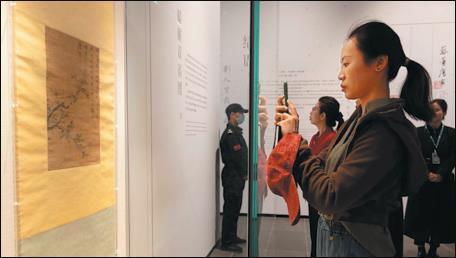

Nanjing — Not far away from where Tang Yin was born, a special exhibition featuring the original paintings and calligraphy of the distinguished master from the Ming Dynasty (1368-1644) took place in East China's Suzhou city.
One particular painting stood out as the exhibition's centerpiece — Two Sparrows on a Tree. The authenticated masterpiece captures the serene beauty of spring as a pair of sparrows revel in nature's embrace.
To commemorate the 500th anniversary of Tang's death, the Suzhou Bay Museum specially curated this exclusive exhibition. It was the first time the masterpiece went on public display since 2010.
"It's considered a treasure of our museum, and rightly so. Genuine paintings by Tang Yin are scarce, with fewer than 200 authenticated pieces known to exist. Among these, work depicting flowers and birds are especially rare, with only two such paintings confirmed to be in existence today," says Ru Yuelai, curator of the Suzhou Bay Museum.
According to the museum, the masterpiece was once again found in the late 1970s.
Its composition, which refers to the techniques of Song Dynasty (960-1279) artists, is exquisitely detailed. Against the backdrop of a camellia tree, Tang depicted a scene in which twin sparrows engage in intimate interaction.
Accompanying the painting is a poem by Tang himself: "Do not take advantage when the mantis loses its nest, someone is taking aim at the birds". Through this verse, the master infused the painting with a profound sense of worldly wisdom that transcends the mere portrayal of flowers and birds.
Better known by his courtesy name Bohu, Tang was celebrated for his multifaceted talent at painting, calligraphy, and poetry. His work predominantly captured the allure of Jiangnan, the region south of the Yangtze River where he was both born and laid to rest.
He emerged from the thriving merchant class of Suzhou, as the eldest son of a restaurant owner. Tang devoted himself to diligent study during his youth, showing little interest in material wealth. His exceptional talent later earned him recognition as one of the preeminent figures of Jiangnan.
However, his life took a dramatic turn after a bribery scandal thwarted his ambitions for further official progress, leading him down a path of artistic indulgence.
Tang's unconventional way of life has inspired storytellers to portray him as a mischievous character in Chinese folklore, a depiction that has been adapted into numerous plays and films.
"I never expected I could appreciate the beauty of my favorite painting in such an immersive dream-scape, it's like a dialogue across time and space," says one visitor surnamed Shi, standing before a digitized version of the masterpiece projected on a large screen.